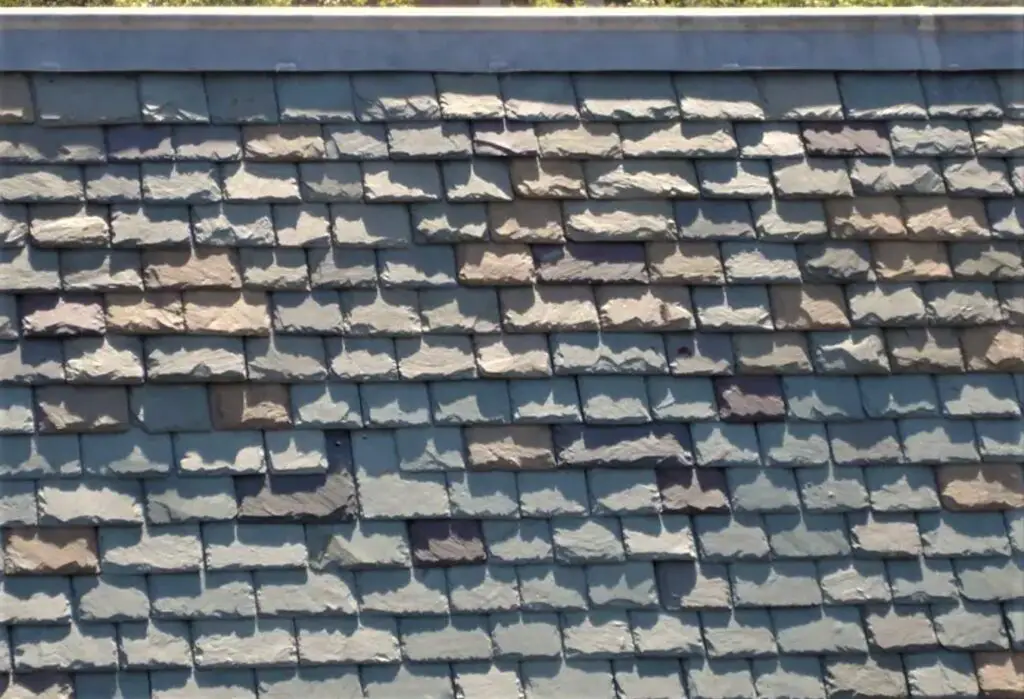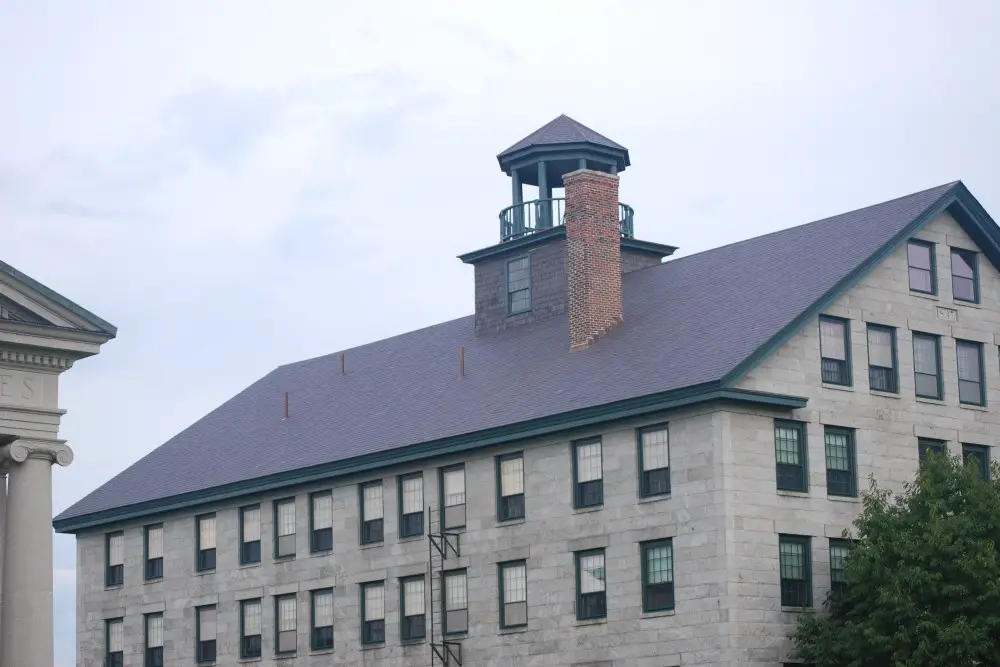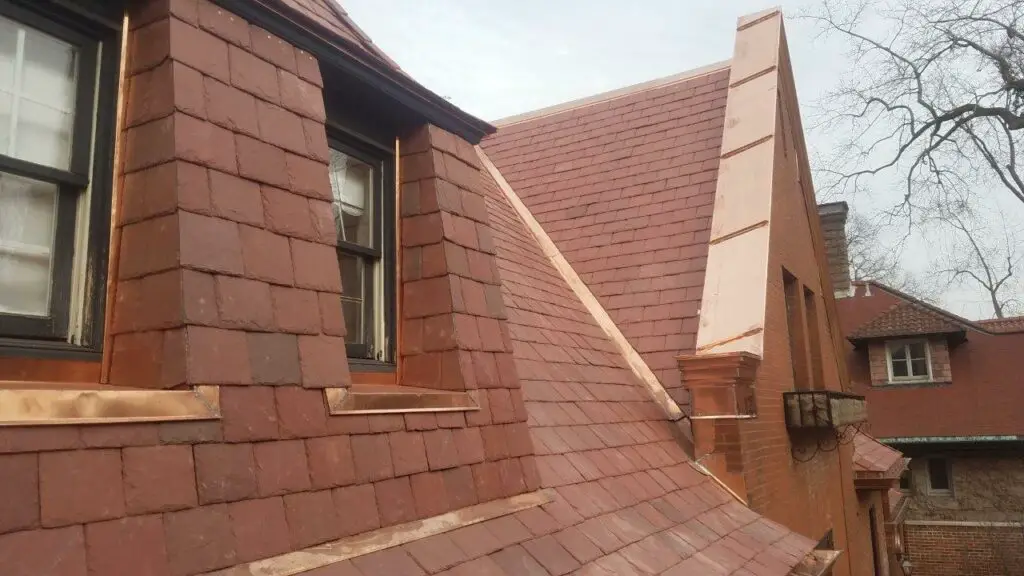Roofing Slate Colors and Where They Come From
By Jack Gray, Roof Online Editor • Last updated February 24, 2024
See our Introduction to Slate Roofing and our Slate Roof Cost Guide for more on slate roofs.

Table of Contents
Introduction to Natural Slate Colors
Natural slate is a durable and beautiful stone roofing material that has been used for centuries. It is also one of the only purely natural roofing materials available. Slate rocks.
Among the most striking features of natural slate roofs are the naturally occurring color variations that provide an array of color options for homeowners.
The National Slate Association lists the available colors for North American roofing slate as black, gray/black, gray, green, gray/green, purple, variegated purple, mottled purple/green, and red. But where do these colors come from, and why are they important for your home?
Slate Formation
Natural slate is a metamorphic rock that has been subjected to intense heat and pressure down inside the Earth’s crust.
Metamorphic rock can take on various, subtle hues depending on the predominant trace minerals present during its formation. The sources of these minerals include volcanic ash, clay, and accumulated organic matter on ancient sea beds.
These mineral additives from hundreds of millions of years ago result in all the different roofing slate colors available today.
The Colors of Roofing Slate
Roofing slate comes in a variety of colors, ranging from soft grays to vibrant purples. The color of the slate is determined by the minerals present in the rock and the geological conditions under which it was formed. The location where the slate was quarried is a huge factor because different areas have different geological histories.
Whatever the color, slate that formed with high levels of mica present is known for its attractive sheen.
Here are some common colors of natural slate roofing and what causes the color:
1. Black Slate
Black slate is a good, traditional color choice for roofing, and it doesn’t show dirt the way lighter colors do. The black color is usually due to a relatively high amount of iron sulfide or carbonaceous material such as graphite. The carbon can typically be traced back to organic matter that accumulated on a seabed. Vermont Black is a well-known black slate.

2. Gray Slate
Gray slate is the most common color of slate roof tiles. It can be sourced from quarries around the world. The gray color comes from the presence of carbon and iron sulfide minerals in the slate (at lower levels than found in black slate).

3. Green Slate
Green slate is a popular choice for roofing because of its unique color. It is often found in areas that experienced mild geological metamorphism. The green color comes from high levels of chlorite minerals and clay. Chlorites do not contain chlorine, despite the similar names (which both simply come from the Greek word for “green”.

4. Purple Slate
Purple slate is a beautiful and unique color for roofing. Purple slate is often found in areas with high levels of iron like Wales or Vermont. Where black or gray slate gets its color from iron sulfide, the purple slate gets its color from the presence of a type of iron oxide called hematite in the slate.

5. Red Slate
Red slate is a warm and inviting color for a roof. Like purple slate, red slate is often found in areas with high levels of iron compounds in the ground. The red color comes from the presence of iron oxide minerals in the slate. Washington County, New York produces a well-known bright red slate.

Fading vs. Unfading Slate Colors
Color stability is a recognized issue in the slate roofing industry.
Roofing slate that changes color with the passage of time and exposure to weather is called “fading” or “weathering”. Roofing slate that remains the same color or changes very little is known as “unfading”.
Fading
“Fading” indicates slate roofing tiles that experience a general lightening in color over time.
Weathering
“Weathering” or “semi-weathering” indicates slates that actually change color over time, typically from the original color to various shades of tan or brown.
Semi-Weathering
“Semi-weathering” is another common term. “Semi-weathering gray slate”, for instance, may change color to a limited extent, retaining much of its original gray color but weathering to brown or tan in some areas.

Unfading
“Unfading” or “non-weathering” are the standard terms used to indicate that the slates will pretty much keep their original color when exposed to the elements over time. Unfading slate may still lose its original color if there’s enough pollution in the air.
The Texture of Roofing Slates
The appearance of slate roof tiles can also be affected by the way the slates are cut and processed, how they are finished, and how thick they are.
For example, some slates may be “cleaved” – split along natural planes of weakness – while others may simply be sawn into thicknesses appropriate for roofing tiles.
Cleaving can produce flat surfaces with distinctively textured grains while sawing and sanding can produce surfaces with a different look. Different types of finishing tools can produce different effects on the finished product, allowing for a range of different roofing slate textures.
How the Color of Roofing Slate Can Affect Your House
The color of your slate roof tiles can have a significant impact on the overall aesthetic and value of your home. Here are some factors to consider when choosing a color of roofing slate:
1. Energy Efficiency
The color of your slate roof tiles can impact the energy efficiency of your house. Darker colors absorb more heat, making them a better choice for cooler climates. Lighter colors absorb less heat, making them a better choice for warmer climates.
2. Style
The color of your roofing slate should complement the style of your home. For example, a gray slate roof is a classic choice for a colonial-style house, while a red slate roof is a great option for a rustic-style home.
3. Resale Value
The color of your roofing slate can impact the resale value of your home. Neutral colors like gray and black are safe choices that appeal to a wide range of buyers. However, unique colors like green and purple can add a touch of personality and make your home stand out.
4. Roof Maintenance
Most homeowners won’t have to worry about this, but there’s a chance that it could be an issue. The color of your roofing slate might affect the maintenance requirements of your home. Lighter colors are more prone to staining and discoloration, while darker colors are more forgiving. Think about whether the need for regular roof cleaning will be an issue before you choose a color.
List of Slate Colors and their Typical Geographic Origin (Quarry Location)
Please note that this list is by no means complete and is only intended to give you an idea of some of the better-known slate quarry locations and what slate colors they are known for.
Blue-Black: Northampton County, Pennsylvania, USA; Ardennes, France; Angers, France; North Wales
Unfading Black: Buckingham County, Virginia, USA; York County, Pennsylvania, USA; Maryland, USA; Quebec, Canada; China; Spain
Gray-Black: Vermont, USA; Washington County, New York, USA
Blue-Gray: Lehigh County, Pennsylvania, USA; Northampton County, Pennsylvania, USA; Esmont County, Virginia, USA; Buckingham County, Virginia, USA; Fluvanna County, Virginia, USA; Vermont USA; Cornwall, England; Ardennes, France; Angers, France
Gray: Vermont, USA; Washington County, New York, USA; Spain; Westmoreland, England; Cumberland, England; North Lancaster, England
Dark Gray: China; Wales
Light Gray: Cornwall, England
Unfading Gray: Northampton County, Pennsylvania, USA
Gray-Green: Spain; Cornwall, England
Weathering Green: Western Vermont, USA; Washington County, New York, USA
Unfading Green: Western Vermont USA; Washington County, New York, USA; Newfoundland, Canada
Unfading Mottled Green & Purple: Western Vermont USA; Washington County, New York, USA; Newfoundland, Canada
Unfading Purple: Western Vermont USA; Washington County, New York, USA; Newfoundland, Canada; Wales
Variegated Purple: Western Vermont USA; Washington County, New York, USA
Unfading Red: Washington County, New York, USA
About the Author
Jack Gray is a principal roof consultant and vice president at the Moriarty Corporation, an award-winning building enclosure consultant firm founded in 1967. He is also the editor of the Roof Online website.

Mr. Gray has worked in the roofing industry for over 25 years, with training and practical experience in roof installation, roof inspection, roof safety, roof condition assessment, construction estimating, roof design & specification, quality assurance, roof maintenance & repair, and roof asset management.
He was awarded the Registered Roof Observer (RRO) professional credential in 2009.
He also served as an infantry paratrooper in the 82nd Airborne Division and has a B.A. from Cornell University. Read full bio.